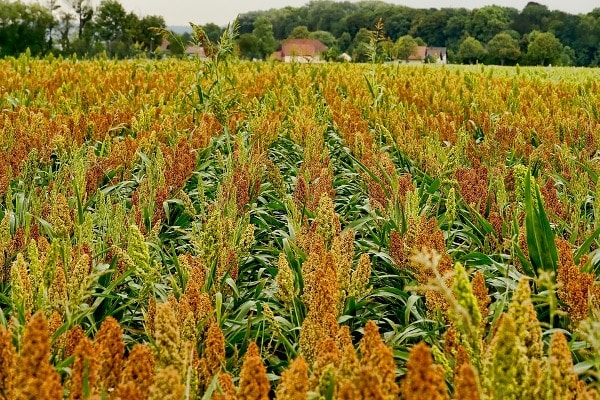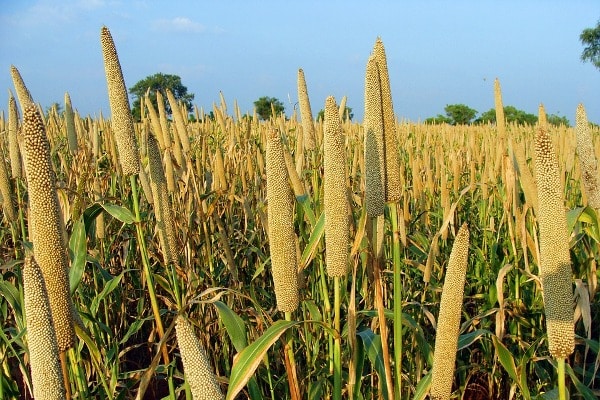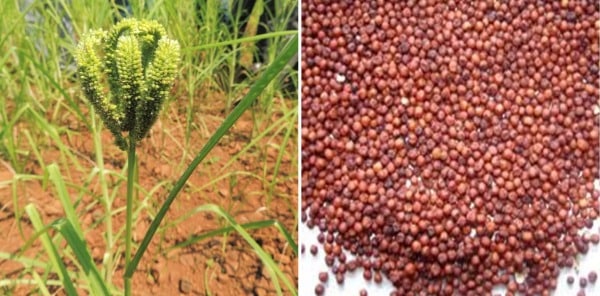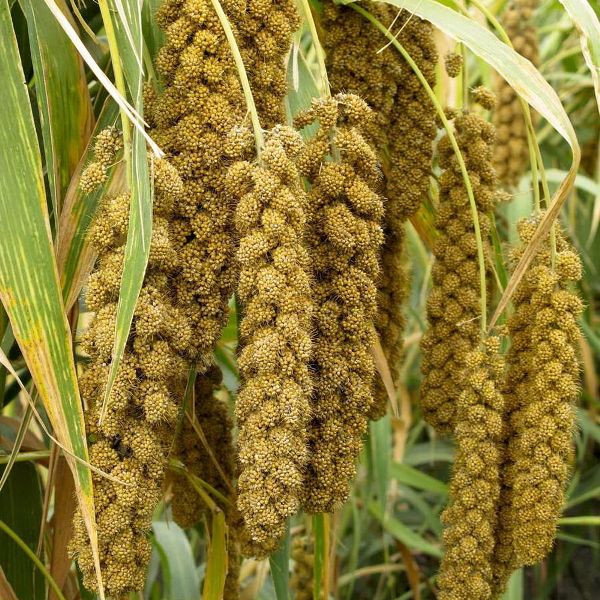Millets Farming, Cultivation Practices
Today, we discuss major millets farming and its cultivation procedure.
Introduction:
The millets are a group of highly variable small-seeded grasses; widely grown around the world as cereal crops or grains for both human food & fodder. They can play a pivotal role in preventing & curing several health issues. Millets contain an incredibly nutrient-rich composition. Enriched with the goodness of nature, millets are a rich source of fiber, minerals like magnesium, phosphorous, iron, calcium, zinc & potassium. Millets are not only healthy, but they have a unique taste, which can accentuate the taste quotient of any meal. India is the largest producer of millets in the world (10,910,000 tonnes).
Millets are high in their nutrition content. Each millet is three to five times nutritionally superior to rice & wheat in terms of proteins, minerals, and vitamins. Millets are rich in B vitamins, calcium, iron, potassium, magnesium, zinc, also gluten-free thus millets are suitable for people with allergies to wheat. Also for a diabetic, weight loss millets are very excellent. In India, millets are mainly cultivated in Uttar Pradesh, Punjab, Andhra Pradesh, Tamil Nadu, Rajasthan, Maharashtra, and Gujarat.
Climate requirements for Millets:
Millets require warm temperatures for germination and development & are sensitive to frost. For these reasons, they are normally planted from mid-June to mid-July month. Optimum soil temperatures for seed germination are between 68°F and 86°F. Proso and foxtail millet are efficient users of water & grow well in areas of low moisture, partly because they are early and thereby avoid periods of drought. Millets are often grown as catch crops where other crops have failed due to unfavorable weather.
Soil requirements for Millets:
Millets produce well on well-drained loamy soils. They will not stand water-logged soils or extreme drought. Proso millet does not make good on coarse, sandy soils.
Seed Preparation and Germination of Millets:
A fungicide will give protection against head smut (Sphacelothaca destruens) and may increase seedling survival.
Cultural Practices:
Seedbed Preparation:
Seedbed preparation for millet is related to that for spring-seeded small grains. Weeds must be controlled prior to planting and the seedbed should be firm and well-worked. Since millets are planted late in the season, spring plowing & farming for weed control are practical.
Method and Date of Seeding:
A seeding rate of 20 lb/acre is suggested for proso millet. Foxtail 2 millet must be sown at a rate of 15 lb/acre. Millets are generally seeded with a grain drill at a depth of one in. Even though the seed is small, it can develop extreme elongation of the first internodes & even deeper unless a hard crust forms. Press wheels on the drill will increase seedbed firmness & aid in stand establishment. Millets compete poorly with weeds; therefore, high seeding rates are essential to establish a dense stand.
Fertility and Lime Requirements:
Nitrogen is usually the most limiting nutrient in millet production. Rates of nitrogen must be based on yield goals & cropping history. Excess nitrogen, whether applied or residual, may affect in lodging. Allow for nitrogen useful as manure or other waste. Phosphorus & potassium should be applied as needed based on soil recommendations. Drill row applications of fertilizer (except straight phosphorus fertilizers) may cause seedling injury & are not recommended. A pH level of 5.6 or higher is recommended for millet.
Introduction of Millets Farming:
Sorghum:
Sorghum is normally known as Jowar in India. Traditionally, Sorghum was used as a grain to make flatbreads or Rotis. Enriched with the goodness of iron, protein & fiber, Jowar can help in reducing cholesterol levels as it has a component called policosanols. Sorghum also called great millet, Indian millet, milo, durra, cereal grain plant of the grass family & its edible starchy seeds.
Sorghum is another one of the ancient cereal grains and grown generally for its fodder value. Sorghum or Jowar has high nutritional value, with high levels of unsaturated fats, protein, fiber, and minerals like phosphorus, potassium, and iron. Sorghum helps to develop metabolism. Sorghum is a strong grass & usually grows to a height of 0.6 to 2.4 meters, sometimes reaching as high as 4.6 meters.
Farming:
Sorghum requires an average temperature of at least 25°C to generate maximum grain yields in a given year. Maximum photosynthesis is attaining at daytime temperatures of at least 30°C. Sorghum or Jowar cannot be planted until soil temperatures have reached 17°C. The long growing season, generally 90 to 120 days, causes yields to be severely decreased if the plants are not in the ground early enough.
Grain sorghum is generally planted with a commercial corn seeder at a depth of 2 to 5 centimeters, depending on the density of the soil. It was created that yields can be boosted by ten to fifteen percent when optimum use of moisture & sunlight are obtained by planting in 25-centimeter rows instead of the conventional one-meter rows. Sorghum, in common is a very competitive crop and does well in competition with weeds in narrow rows. However, herbicides are still used to control the weed problem so that the plants create an economically viable crop of grain.

Insect & diseases are not prevalent in sorghum crops. Birds, however, are the main source of yield loss. The crop may be attacked by corn earworms, aphids, and some Lepidoptera larvae, including turnip moths. Sorghum is a high nitrogen feeding crop. An average hectare producing 6.3 metric tons of grain yields requires 110 kilograms of nitrogen, but moderately small amounts of phosphorus and potassium. Sorghum’s growth habit is like that of maize, but with more side shoots & a more extensive branched root system. The root method is very fibrous and can extend to a depth of up to 1.2 meters. Wild species of sorghum tend to develop to a height of 1.5 to 2 meters; however, due to problems this height formed when the grain was being harvested; in recent years cultivars with genes for dwarfism have been selected, resulting in sorghum that develops to between 60 and 120 centimeters tall.
The plant finds 75 percent of its water in the top meter of soil, and since, in dry areas; the plant’s production can be severely affected by the water-holding capability of the soil. The plants require up to 70 to 100 millimeters of moisture every ten days in the early stages of growth. Sorghum progresses during growth stages & the roots penetrate more deeply into the soil to tap into hidden water reserves; the plant needs gradually less water. By the time the seed heads are filling, optimum water conditions are down to about 50 millimeters every ten days. Compacted soil topsoil can limit the plant’s ability to deal with drought by limiting its root system. Since these plants have evolved to grow in hot, dry areas, it is necessary that the soil is kept from compacting & that they are grown on land with ample cultivated topsoil.
Even in a long drought, severe enough to hamper sorghum production, it will still generally produce some seeds on smaller and fewer seed heads. Sorghum’s ability to thrive with less water than maize may be due to its capability to hold water in its foliage better than maize. Sorghum has a waxy coating on its leaves & stems which helps to keep water in the plant even in intense heat.
Pearl Millet or Sajjalu:
Pearl millet is the most widely grown type of millet & India is the largest producer of pearl millet. Pearl millet is the second important millet of India. Pearl millet is a rich source of phosphorus, which plays an important element in the structure of body cells. It is also called Bulrush millet, Babala, Bajra, Dukhn, Gero, Sajjalu, or Souna. Sowing takes place between May and September, and harvesting between September & February. The plants are tall, annuals, growing to a height of from 1.8 to 4.5 inches.
Farming:
Pearl millet varieties are hybrids, so new seeds should be purchased each year. Producers seeking grain-type pearl millet are cared to clarify that the seed they are purchasing is not a forage type pearl millet, of which there are several varieties obtainable. The forage types are much taller (7 to 8 feet) and have a small seed yield.
Soil temperatures should be at least 65°F., and rather warmer before pearl millet is planted. In optimum planting time is early June, with a range of mid-May to mid-June being suitable. The seeding rate is recommended at four pounds per acre. An exact seeding rate is not critical, because pearl millet can moderately compensate for a poor stand by increasing the number of tillers. Seeding depth should be 1/2 to one inch deep. No-till seeding is feasible, although the shallower seeding depth compared to corn or soybeans can create proper control of planter depth more challenging.

A variety of row widths are suitable with grain-type pearl millet. Previous work with pearl millet in the Midwest has normally been based on 30-inch row widths, which allow row crop farming for weed control. At this row width, pearl millet will generally have sufficient leaf development to “close the row.” In other states, narrower rows have generally given a yield improvement over wide rows, with yields optimized at 15-inch spacings and at narrower spacings, such as 7 – 8 inches. The narrower rows prevent by a cultivator for weed control, but ground shading by millet leaves occurs earlier, helping suppress some weeds. On sandy or poor fertility soils, wider row spacings may be better since they will permit individual plants to develop more lateral roots, due to less row-to-row competition.
Pearl millet is well adapted to rising areas characterized by drought, low soil fertility, and high temperature. Pearl millet performs well in soils with high salinity or low pH. Because of its tolerance to hard growing conditions, it can be grown in areas where other cereal crops, such as wheat, would not survive. Pearl millet is a summer annual crop, well-suited for double cropping & rotations. Today pearl millet is developed on over 260,000 km2 of land worldwide. It accounts for about 50% of the entire world’s production of millets.
Finger Millet or Ragi:
It is also known as African finger millet, red millet, ragi, and very popular millet especially in Southern India. It is rich in calcium and protein and has a good amount of iron and other minerals. Finger millet tops in antioxidant activity among common Indian foods, Ragi have a good number of Essential Amino Acids (EAA) which are necessary for the human body. Ragi is used as a healthy substitute for rice & wheat. Finger millet is undoubtedly a powerhouse of nutrition. Loaded with protein and amino acids, this gluten-free millet is very good for brain development in growing kids. Ragi is the best millet for weight loss because; it has the highest content of calcium. And also have a high fiber content that makes it an excellent food option to manage your weight.
Finger millet may be grown as a hot weather crop, from May to September, using long-duration varieties and as a cold season crop, from November and December, using early types. An application of farmyard manures at eight to ten tons/ha is recommended in order to develop the soil organic matter content, moisture retention ability & soil structure. Phosphorous must be applied in the form of rock phosphate. Weeding must be done twice; 2 to 3 weeks after emergence and about two weeks later. Early land training is recommended. A fine seedbed suitable for small grains is required, to ensure good germination, plant population density & effective weed control. Most soils except coarse sand are appropriate for its farming.

Finger millet is mono-cropped in India under irrigation or transplantation. Rain-fed it is mostly intercropped with cereals, castor bean, Niger, groundnut & pulses. The most common subsidiary crops developed with ragi are field beans, pigeon pea (Cajanus cajan), cowpea (Vigna sinensis), and niger. With groundnuts, Finger millet is the subsidiary crop. Liberal manure, mainly sheep & cattle, is applied. Green manures such as cowpeas, sun hemp, artificial manures & oil cakes, have been used on both irrigated and unirrigated crops. Finger millet is chopped and weeded at intervals of 14 days or so. The number & frequency of irrigations vary with seasonal conditions.
Foxtail Millet or Korralu:
Foxtail millets are high in Iron content & these millets are totally pest-free. Foxtail millet does not need any fumigants but acts as an anti-pest agent to store delicate pulses such as green gram. They control blood sugar and cholesterol levels & increase HDL cholesterol.
Foxtail millet has healthy blood sugar balancing carbohydrates, and it is popularly available in the form of semolina & rice flour. The presence of iron & calcium in this millet helps in strengthening immunity.
Farming:
In India, foxtail millet is still an important crop in its arid & semi-arid regions. In South India, foxtail millet has been a staple diet among people for a long time from the Sangam period. In China, foxtail millet is the most common millet & one of the main food crops, especially among the poor in the dry northern part of that country. In Southeast Asia, foxtail millet is generally cultivated in its dry, upland regions. In Europe and North America it is planted at a moderate scale for hay & silage, and to a more limited extent for birdseed. In the northern Philippines, foxtail millet was once the main staple crop, until its later replacement of wet-rice and sweet potato farming.

Foxtail millet is a warm-season crop, normally planted these millets in late spring. Harvest for hay or silage can be made in 65 to 70 days (typical yield is 15,000 to 20,000 kg/ha of green matter or 3,000 to 4,000 kg/ha of hay), and for grain in 75 to 90 days (typical yield is 800 to 900 kg/ha of grain). Its early maturity and efficient use of available water makes it appropriate for rising in dry areas.
Kodo Millet:
Kodo millets contain high amounts of polyphenols, an antioxidant compound, they have high fiber, low on fat. Kodo millet inhibited glycation & cross-linking of collagen. Kodo millets are very good for diabetes. Kodo millet is easy to digest; it contains a high amount of lecithin & is very excellent for strengthening the nervous system. Kodo millets are rich in B vitamins, mainly niacin, B6, and folic acid, as well as the minerals such as calcium, iron, potassium, magnesium & zinc. Regular consumption of Kodo millet is very beneficial for high blood pressure and high cholesterol levels.
Farming:
Generally, the Kodo millets are grown in tropical as well as sub-tropical up to an altitude of 2,100m. It is a heat-loving plant. It is grown where rainfall ranges from 500 to 900mm. Kodo Millet has a heavy water requirement which grows well in moderate rainfall of 50 to 60 cm.
Kodo millet is propagated from seed, preferably in row planting instead of broadcast sowing. Its chosen soil type is very fertile, clay-based soil. Kodo millet is better suited to dry conditions which require about 800 to 1200 mm of water annually and is well suitable to sub-humid arid conditions. With very low competition from other plants or weeds for nutrients, it can develop well in poor-nutrient soils. However, it does best in soils supplemented with a common fertilizer. The recommended dose for optimal development is 40 kg of nitrogen plus 20 kg of phosphorus per hectare. India’s Rewa district in 1997 showed a 72% increase in Kodo millet grain yields as opposed to no fertilizer. Kodo millet prefers full light for optimal growth but can tolerate partial shading. Its ideal temperature for growth is 25 to 27°C. It requires four months until maturity & harvesting.
Proso Millet:
Proso millet has also been called common millet, hog millet, broom corn, yellow hog, Hershey & white millet. Proso millet is a warm-season grass capable of producing seed from 60 days to 100 days after planting. Because of its relatively short growing season, it has a low moisture requirement & is capable of producing food or feed where other grain crops would fail.
Farming
Proso millet is a relatively low-demanding crop & diseases are not known; consequently, proso millet is often used in an organic farming method in Europe. In the United States, it is used as an intercrop. Thus, proso millet can help to avoid a summer fallow, & continuous crop rotation can be achieved. The stubbles of the last crop, by allowing more heat into the soil, resulting in a faster & earlier millet growth. While millet occupies the ground, because of its superficial root method, the soil can replenish its water content for the next crop. Later crops, for example, winter wheat, can in turn advantage from the millet stubble, which acts as snow accumulates.
Due to its photosynthetic organism, proso millet is thermophilic like maize. Therefore, shady locations of the field must be avoided. It is very sensitive to cold temperatures lower than 10 to 13 degrees Celsius. Proso millet is highly drought-resistant, which makes it of interest to regions with low water availability & longer periods without rain. The soil must be light or medium-heavy. Due to its flat root methods, soil compaction must be avoided. Furthermore, proso millet does not tolerate soil wetness reason of dammed-up water.
The seedbed must be finely crumbled as for sugar beet and rapeseed. In Europe, proso millet is sown between mid-April & the end of May. In organic farming, this amount must be increased if a harrow weeder is used. For sowing, the usual sowing machines can be used also to how they are used for other crops like wheat. A distance between the rows of from 16 centimeters to 25 centimeters is recommended if the farmer uses an intro cultivator. The sowing depth must be 1.5 up to 2 cm in optimal soil or 3 to 4 cm in dry soil. Rolling on the ground after sowing is useful for further farming. Farming in no-till farming systems is possible and often practiced in the United States. Sowing then can be done 2 weeks later.
Millets diseases and their control:
Head Smut (Sphacelotheca destruens) can be a problem in proso millet but can be restricted by seed treatment.
Kernel Smut (Ustilago crameri) can be present in both proso millet and foxtail millet. This disease requires seed treatment & crop rotation for effective control, as the inoculum will remain in the soil for several years.
Grain mold is a major disease in sorghum and occasionally may be observed on pearl millet & finger millet. First visible symptoms on sorghum appear on spikelet tissues as pigmentation of the lemma, palea or glume, or fungal growth on anthers & filaments.
Insects and Mites and their control:
Wheat Curl Mite – Foxtail millet is recognized to harbor this insect which may transmit wheat streak mosaic to winter wheat. Cutting foxtail for hay by early August & then undercutting the stubble must kill the crop and prevent it from acting as a host.
Grasshoppers – Grasshoppers insect has been the most serious on millets. Insecticides are cleared for use on millets to manage grasshoppers. Armyworms – Armyworms insect can be prevalent, but can be controlled by insecticides.
Harvesting methods of Millets:
Millets are ready for harvest when seeds in the upper half of the panicle are mature. Seeds in the lower half of the panicle may still be in the dough stage but must have lost their green color. At this point, the leaves & stems may still be green. Millet is generally harvested by swathing to allow drying of straw before combining. Swathing too early reduces yield, test weight & color quality. Harvesting too late increases loss as a result of shattering & lodging. Rodents and birds can source damage to proso millet during ripening. Control programs are often required.
Foxtail millet must be harvested for hay or silage from the late boot to the bloom stage. At this stage, hay quality is at its peak, and protein levels of 12 to 14% may be regular. As the plant matures, protein refuses. Also, mature bristles from delayed harvest may cause lump jaw & sore eyes in cattle feeding on bunks. When harvesting foxtail millet for seed production, it must not be cut until completely ripe, then swathed and threshed. Sometimes it is directly combined after a killing frost, but seed loss will occur.
In case if you are interested in this: Onion Growing Tips, Tricks, and Secretes.
- Economical Aquaculture: A Guide to Low-Budget Fish Farming
- 15 Common Planting Errors That Can Doom Your Fruit Trees
- How to Make Houseplants Bushy: Effective Tips and Ideas
- Innovative Strategies for Boosting Coconut Pollination and Yield
- Pollination Strategies for Maximum Pumpkin Yield
- The Complete Guide to Chicken Fattening: Strategies for Maximum Growth
- Natural Solutions for Tulip Problems: 100% Effective Remedies for Leaf and Bulb-Related Issues
- Revolutionizing Citrus Preservation: Towards a Healthier, Greener Future
- Natural Solutions for Peony Leaf and Flower Problems: 100% Effective Remedies
- Maximizing Profits with Avocado Contract Farming in India: A Comprehensive Guide
- Natural Solutions for Hydrangea Problems: 100% Effective Remedies for Leaf and Flowers
- The Ultimate Guide to Choosing the Perfect Foliage Friend: Bringing Life Indoors
- From Sunlight to Sustainability: 15 Ways to Use Solar Technology in Agriculture
- The Ultimate Guide to Dong Tao Chicken: Exploring from History to Raising
- The Eco-Friendly Makeover: How to Convert Your Unused Swimming Pool into a Fish Pond
- Mastering the Art of Delaware Chicken Farming: Essentials for Healthy Backyard Flocks
- 20 Best Homemade Fertilizers for Money Plant: DIY Recipes and Application Methods
- How to Craft a Comprehensive Free-Range Chicken Farming Business Plan
- Brighten Your Flock: Raising Easter Egger Chickens for Beauty and Bounty
- How to Optimize Your Poultry Egg Farm Business Plan with These Strategies
- Subsidy for Spirulina Cultivation: How Indian Government Schemes Encouraging Spirulina Farmers
- Ultimate Guide to Raising Dominique Chickens: Breeding, Feeding, Egg-Production, and Care
- Mastering the Art of Raising Jersey Giant Chickens: Care, Feeding, and More
- Ultimate Guide to Raising Legbar Chickens: Breeding, Farming Practices, Diet, Egg-Production
- How to Raise Welsummer Chickens: A Comprehensive Guide for Beginners
- How to Protect Indoor Plants in Winter: A Comprehensive Guide
- Ultimate Guide to Grow Bag Gardening: Tips, Tricks, and Planting Ideas for Urban Gardeners
Tq nice article..
Where can I buy the unhusked positive, Sridhanya Millets to grow? THANKS
Where can v get the seeds of various millets?